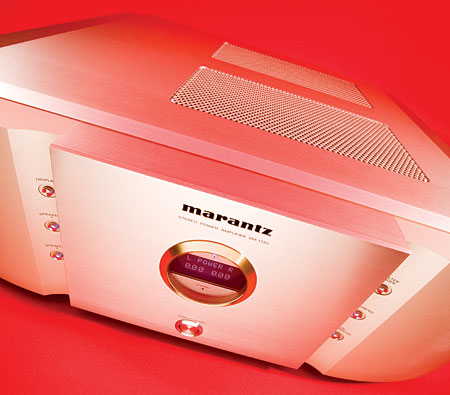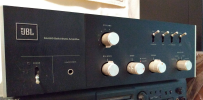This is a review and detailed measurements of the JBL SA600 vintage (1966) stereo amplifier. It is on kind loan from a member.
View attachment 227934
The classic look endures the test of time. It is more usable and stylish than many amps of today. Inputs though, are oddly placed underneath the unit:
View attachment 227935
Prices for these can go way up with one currently listed at US $5,600!
Here is the background from the owner:
"“This was an estate find that came with an original owner’s manual (not a photocopy!) that looked and sounded great albeit with a large channel imbalance. I reached out to Peter to do a “classic car” restoration in that I wanted to figure out how to keep this amp running another 60 years from now but to also keep things as close to original as possible instead of doing a restoration-modification like transforming a vintage car with a Tesla powertrain. I’d like to send it to Amir after restoration so we have an rough estimate of how the very first solid state integrated amps from the 1960s likely performed. This amp is interesting because JBL didn’t know how the amp performed because it was at the limit of the test equipment at the time before negative feedback was applied, so no one really knows how it performs once negative feedback was applied. I sent Peter a full set of new-old-stock JBL branded, Motorola manufactured transistors from a different estate sale from someone’s whose dad worked closely with Ed May. Per Peter, several of these transistors had already deteriorated on their own, but he was able to use a few of them in the restoration.”
Peter is humble, and
I would add that he spent about a year researching the idea and reviewing the technical and original designer’s writings before actually embarking on the restoration. This is almost a 2 year project! Ironically with the goal of not making it “too good” that it would defeat the purpose of having a benchmark to compare against."
And notes from Peter from Quirkaudio:
"The SA 600 has four PCB.
The power supply new electrolytic capacitors throughout with, in the main supply, the original 4500Uf 40v replaced with low ESR 10k 63v. The diodes were also replaced with 5A ultrafast types. The secondary voltages of which there are three, also had the original 1000uf 6v replaced with 2200uf 25v and the diodes again replaced with 1A ultra fast types. The film caps were also replaced as were the dropping resistors.
The preamp board had all of the electrolytic caps replaced, with a combination of low impedance and audio types, including the Nichicon Muse UES BiPolar types, depending on function. Some of the values were increased where appropriate. The film caps were mostly replaced with polypropylene or polyester depending on function. A number of ceramic capacitors were also replaced, generally with WIMA polypropylene.
Each main amp channel has a single PCB. The input pair were replaced with low noise modern transistors, and all the electrolytics were also replaced, again with a combination of low ESR and audio types as applicable. The input filter cap was replaced with a polypropylene film type as were the ceramic caps. The power rail caps were increased in capacity slightly. The main output transistors were all replaced with modern OnSemi types as they all measured poorly. Some of the resistors on the main amp boards were also replaced, mainly to reduce noise at input and feedback."
Here are the distortion and power specs:
View attachment 227943
JBL SA600 Measurements
While there is a set of pre-outs, they seem to be just pass through so I measured the amp as a whole unit. Here is our dashboard:
View attachment 227936
Not a pretty picture although much of the fault falls on the shoulders of the power supply. The 120 Hz harmonic dominates SINAD at just 40 dB. If we replace that power supply with an ideal one, SINAD would be around 60 dB given the second harmonic at -65 dB.
As noted in the intro and in my measurements, channel balance is quite off although it depends partially on the volume control position. In the review image you can see where I had to set it for the measurements.
SNR suffers of course due to that power supply noise:
View attachment 227937
Then again at full power it is dominated by distortion which is close to what I guessed.
There is no tone defeat. With the controls not be precise at center position, response was quite variable:
View attachment 227938
The solid lines are the closest I could get to a flat response without too many trials. The peaking is above audible band fortunately. The low frequency cut off is not. The input is capacitor coupled so some of that roll off is due to that. Here is the effect of the loudness control:
View attachment 227940
Multitone shows the level of distortion we saw in the dashboard:
View attachment 227941
Crosstalk was quite poor:
View attachment 227942
Here is our power response:
View attachment 227945
View attachment 227946
Even allow for more distortion I could not reach the spec:
View attachment 227947
I then attempted to run my frequency vs power sweep but the amp shut down with the first test (20 kHz). The fuse blew and unfortunately I don't have a slo blow 2 amp one to put in there. I have one on order. Hopefully that is all it is and not a blown output stage.
 Conclusions
Conclusions
1966 is a long, long time ago. We are talking early decade in life of transistor amplifiers. Was this a good attempt or not? Based on current measurements it is not but there is no way to know how it originally performed. Company specs are certainly a lot better than what I am seeing. Maybe the power supply can be further improved. Not sure.
------------
As always, questions, comments, recommendations, etc. are welcome.
Any
donations are much appreciated using
: https://www.audiosciencereview.com/forum/index.php?threads/how-to-support-audio-science-review.8150/







